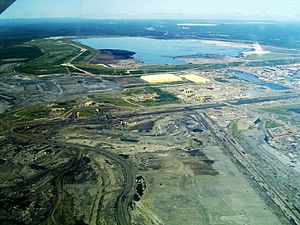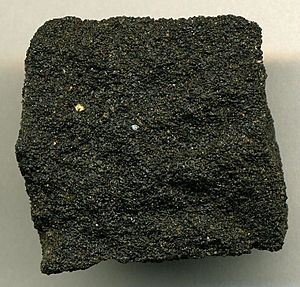Oil sands facts for kids
Oil sands, also known as tar sands, are a special type of petroleum source. They are a mix of sand, clay, water, and a very thick, sticky form of oil called bitumen. Think of bitumen like very thick, natural tar!
You can find natural bitumen in many countries. The biggest amounts are in Canada, Kazakhstan, and Russia. Experts believe there might be more than 2 trillion barrels of oil in these sands worldwide. About 70% of all the known oil sands are in Canada.
Oil made from bitumen sands is often called unconventional oil. This helps us tell it apart from regular liquid oil. Getting this oil out of the ground and turning it into fuel uses a lot of energy. It also creates about 12 percent more greenhouse gases than making traditional oil. Because of this, oil sands were not always seen as a major oil source. But now, with higher oil prices, it has become profitable to extract and process them.
Impact on Our Planet

Getting oil sands out of the ground can damage large areas of land. A lot of water is needed to separate the oil from the sand. This water often becomes polluted afterward. The process also releases Carbon dioxide and other gases into the air, which adds to air pollution.
Many environmental groups are concerned about the damage caused by oil sand extraction. Groups like Greenpeace, The Climate Reality Project, and Sierra Club have criticized these operations.
In 2012, the European Union (EU) considered labeling oil from oil sands as "highly polluting." This idea caused some disagreement between the EU and Canada.
More to Explore
Images for kids
-
Demonstration of citizens against tar sands and the Keystone Pipeline.
See also
 In Spanish: Arenas petrolíferas para niños
In Spanish: Arenas petrolíferas para niños








